How Fibery Uses Fibery for Product Development
We’ve been working on Fibery for almost 4 years already. And we started to use it for our own needs about 2.5 years ago. You can imagine that our work process changed a lot and I’m happy that Fibery survived all the changes from 6 to 20+ people. In this article, I will explain how we use Fibery for product management to track almost everything, from high-level goals to payment transactions.
Fibery is a connected workspace for teams.
I’ll scare you right away just for fun, here are all the Spaces in our workspace. 2–3 of them are legacy, but we do use almost all of the Spaces:
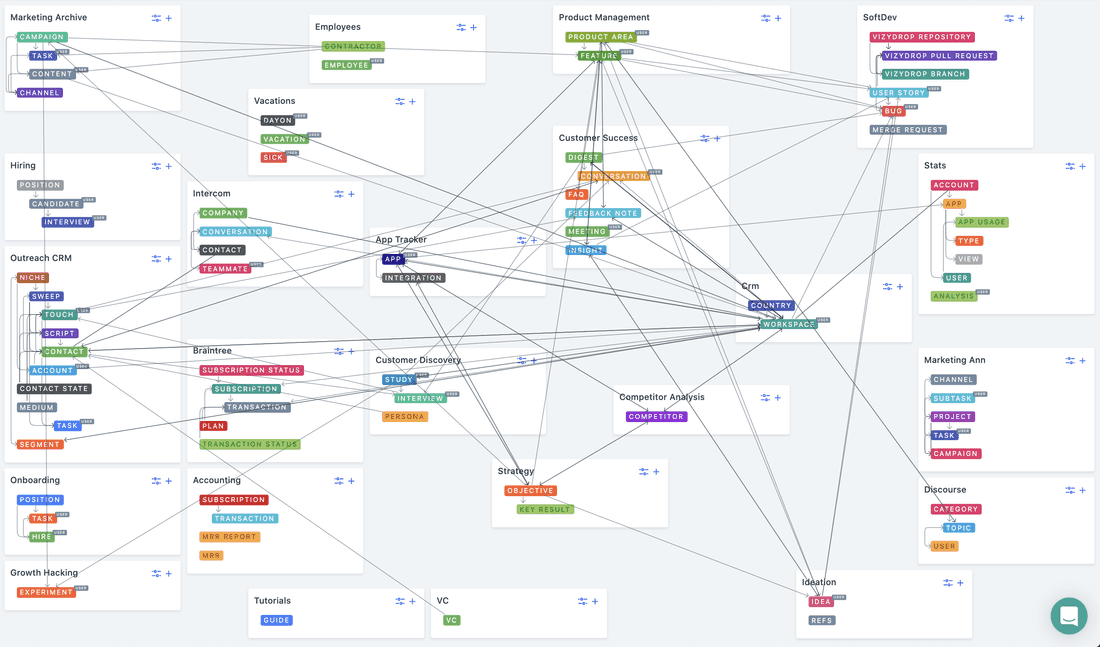
Space usually represents a process. For example: Software Development, Candidates tracking, Vacations tracking, CRM, etc.
I will not cover all the processes but focus on the most important. These Spaces are accessible to all team members.
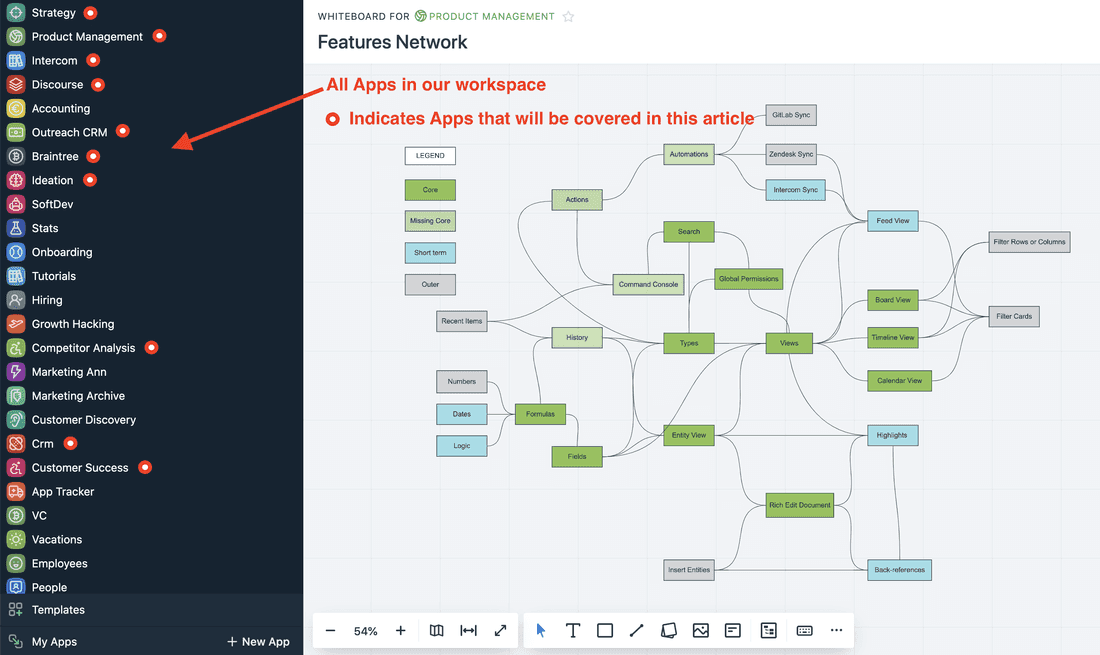
Strategy
We use a basic OKR space with Objectives and Key Results. However, we connect Ideas & Features to the Objectives to see what we really do to make it happen.
First, we define the main strategic theme for a couple of months. Our current Objective is to release Fibery for Product Companies and find a market fit. To start this thing, we did marketing research and wrote a couple of analytical documents, all of them are attached to this Objective. Also, you can see the Key Results table and Features Roadmap below:
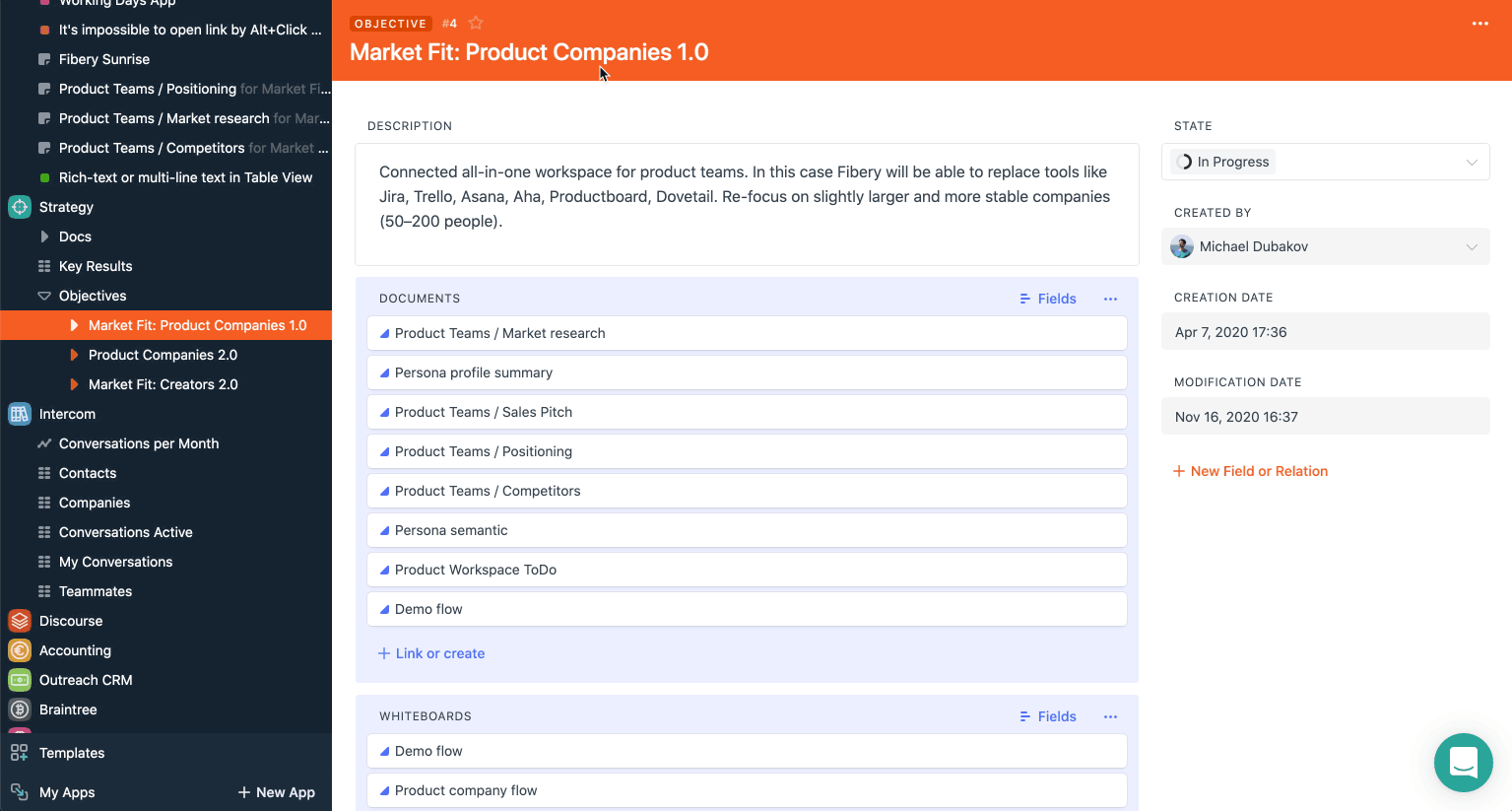
We’ve started Fibery for Product Teams implementation in May, and are going to release it in January 2021, so it’s a year-long Objective in fact (we have to get 100 paid product companies with 2% conversion rate to meet the goal, and it might take a couple of months after the release).
Product Roadmapping
We don’t use complex hierarchies for Product Roadmapping, we just use Features. We split them into three categories: Must Have, Strong Desire, and Maybe. We try to focus on “Must Have” first, so the first lane is busy.
In the ideal world, all features should be related to the current Objective, but in reality, that is not always the case. For example, we have to move to the new infrastructure now, but it has nothing to do with product companies’ focus. Overall we are able to maintain 80% focus and rarely add features that don’t fit the current goal.
Here is our roadmap. We’re close to the release date, so most of the Must Have features are completed.
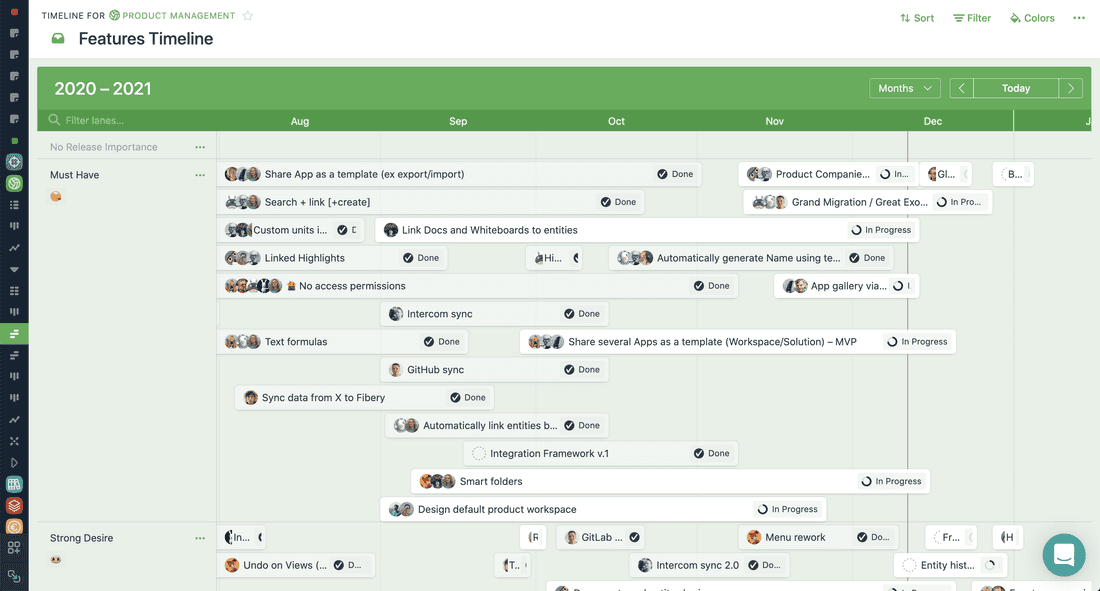
Every Feature is well documented right here, we don’t need any external wiki, since the collaborative document is embedded. We usually split every Feature into a couple of User Stories and attach all found Bugs. Usually, Feature has 2–3 people assigned, but some Features are smaller and only one person works on them.
Here is a Feature example. It’s somewhat messy, but it’s life…
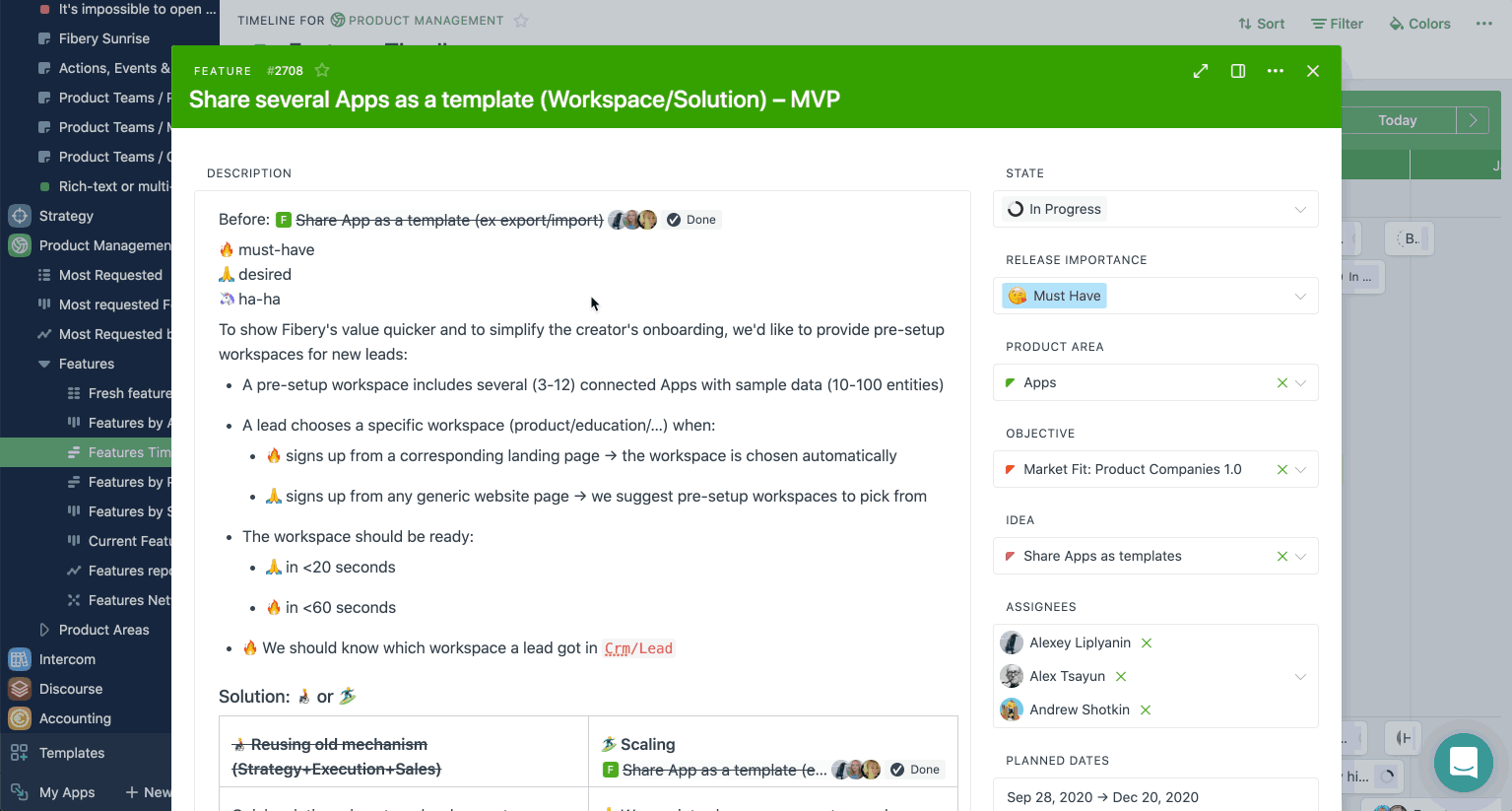
Feedback management
This is where Fibery really shines for us. We have three main sources of feedback: Intercom chats, Discourse conversations, calls with customers, and leads. We put all these into Fibery.
Intercom
We use Intercom heavily and have about 300 conversations each month. Almost all these conversations are handled by a single person, Polina. When a conversation is over, she goes to Fibery and links interesting points to Insights, Features, or Ideas. In this example, feedback is linked to Insight “Users expect import update data, not only add a new one”.

Later we review frequent Insights, and some of them lead to Features or User Stories.
Discourse
We use Discourse as a community platform, so you can imagine there are many interesting discussions going on here. We sync all Discourse discussions into Fibery and link them to Ideas & Features.
“Every program attempts to expand until it can read mail. Those programs which cannot so expand are replaced by ones which can.” — Jamie Zawinski
Here we have a new idea to integrate Fibery with Email to support Jamie Zawinski Law
I read the feedback and create a new Idea from it. Note that the original feedback is linked to this Idea (all such links in Fibery are bi-directional).
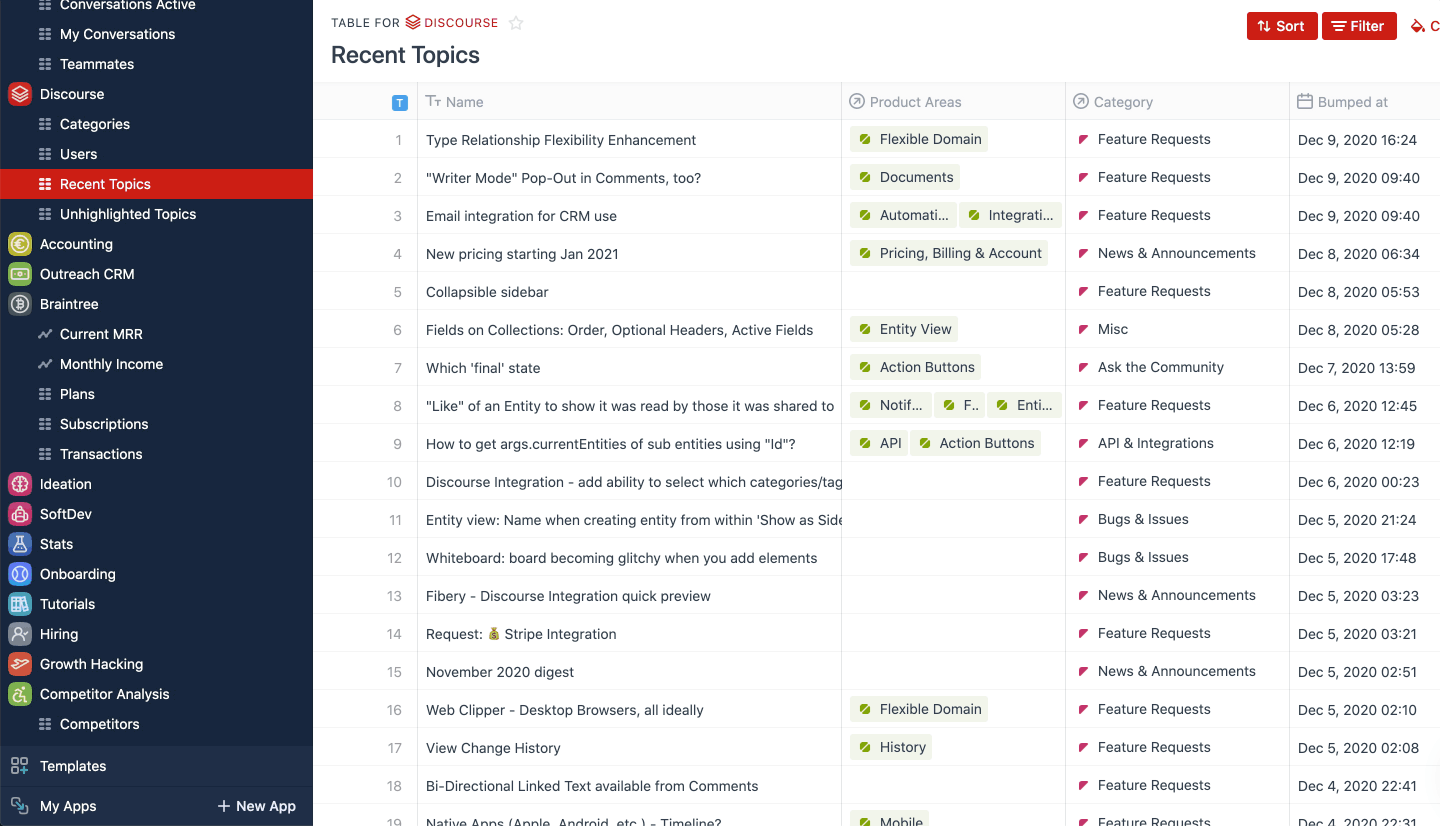
Conversations
All conversations (calls, demo, etc.) are documented, we do take all meeting notes carefully and link all mentioned problems and feedback to real entities in Fibery.
Here is a conversation between Anton and our customer. You can see quite many links to existing Features and Bugs. The good thing is that you see all features and bug states right here and can assign people right here as well to fix bugs or implement things. So when you decide to review this conversation next month, you will see what is already done and you may decide to have a new call with a customer about the progress.
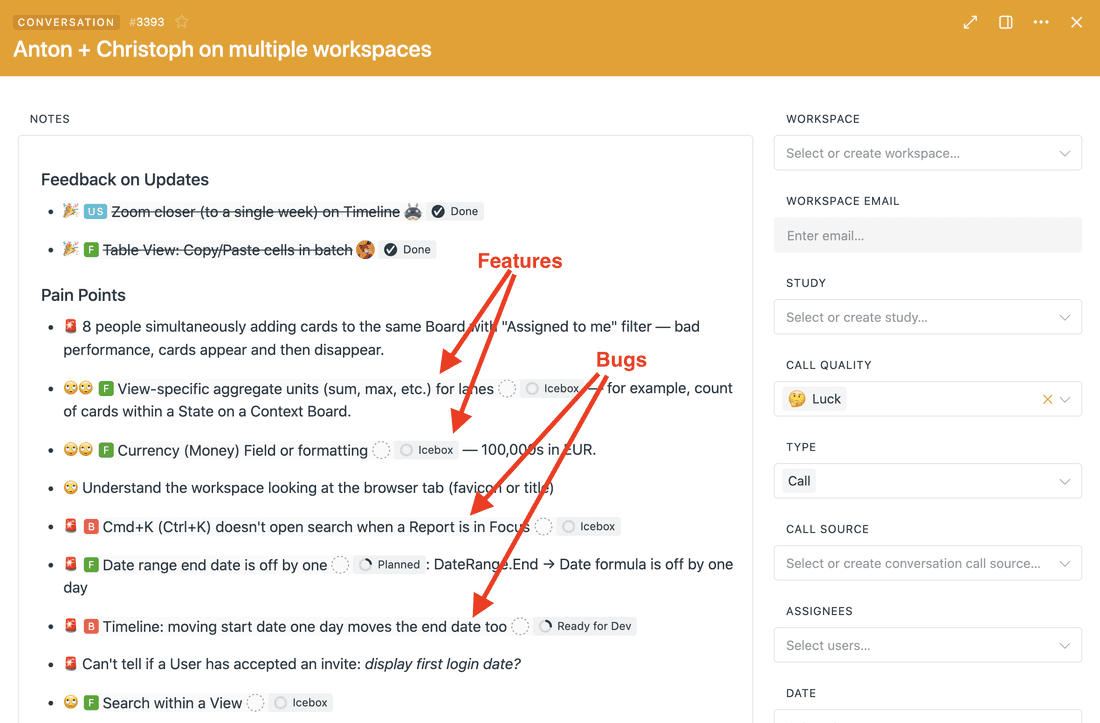
Note how we use emoji to indicate feedback importance. 🚨 indicates missing Fibery functionality, while 🙄 is a feature request. The number of emojis (from 1 to 3) describes the impact: from a 🚨 slight annoyance to a 🚨🚨🚨 showstopper.
Build Product Around Customer Needs
Btw it adapts to your team and grows with it.
Accumulated feedback → Better prioritization
The goal of these activities is to aggregate real feedback and understand what to work on next. How are we really doing it? We have a single product and we split it into Product Areas. Then we link Features and Ideas to Product Areas, sometimes we link direct feedback.
For example, we have feedback about Email integration but don’t have a Feature or Idea for this yet. In this case, we just link this feedback to Integrations Product Area. Here is Integrations Product Area with all linked entities:
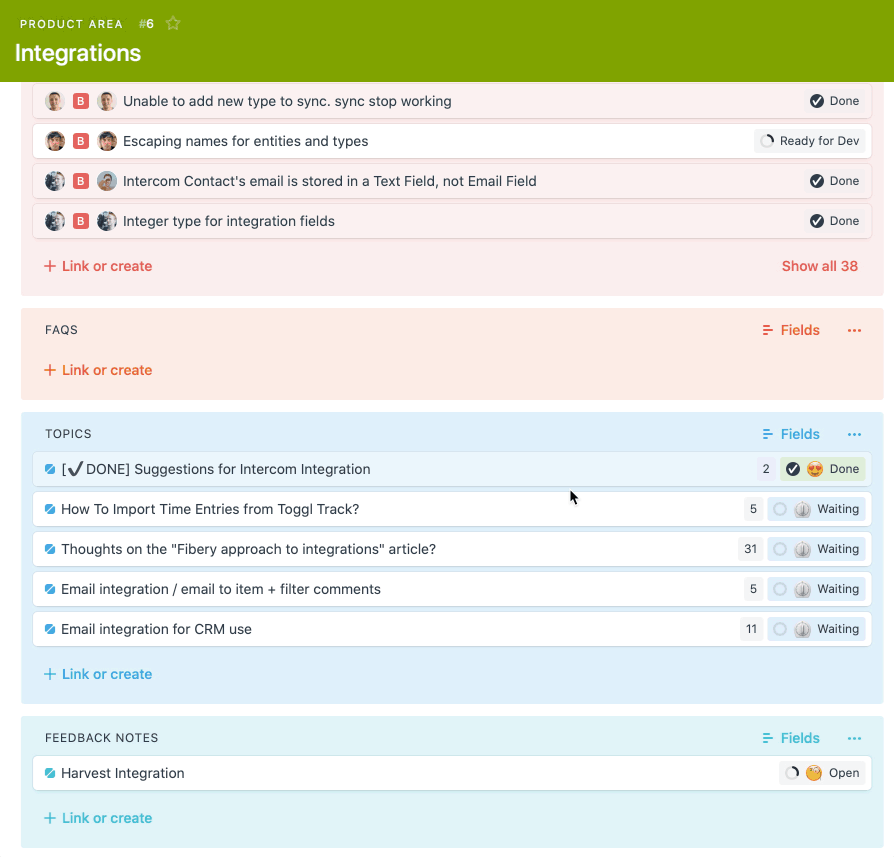
Then we can count all references inside a Product Area and build a nice chart that shows the most frequently mentioned areas of Fibery. We have quite a lot of requests about Views, Integrations, and Permissions, so it seems we should focus on these things.
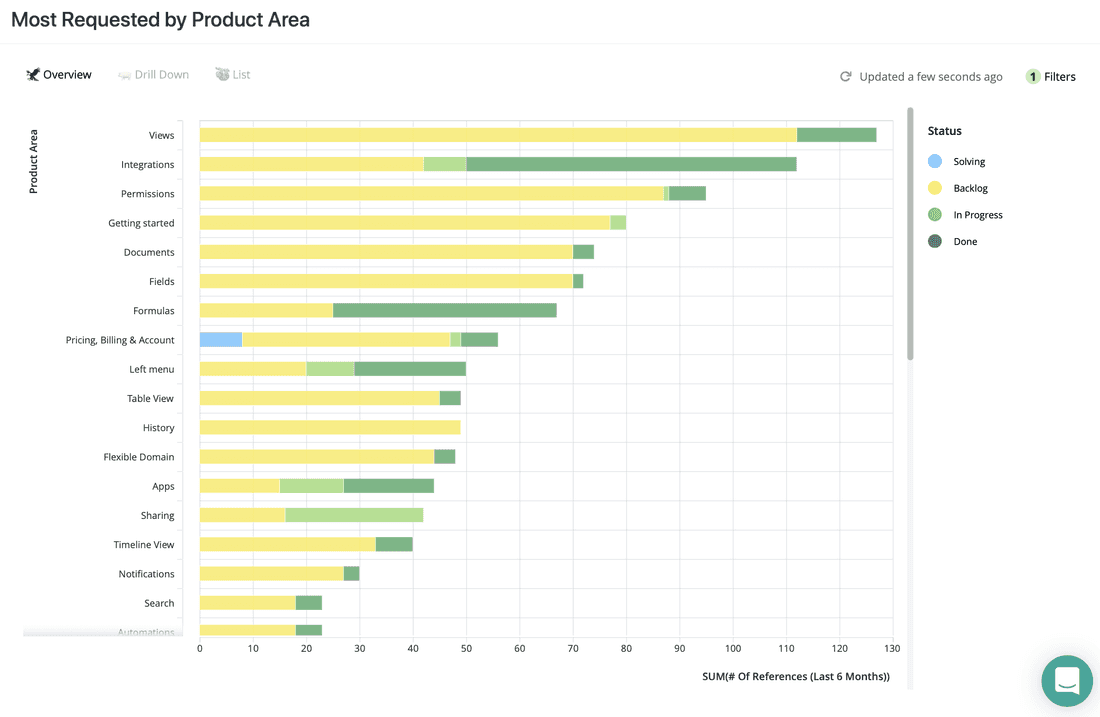
However, this is too high level to make concrete conclusions. For the repeating requests, we create Ideas or Features and link feedback to them. It enables us to clearly see the top requested things. Remember, this is aggregative feedback from all sources: Intercom, Calls, Community Forum.
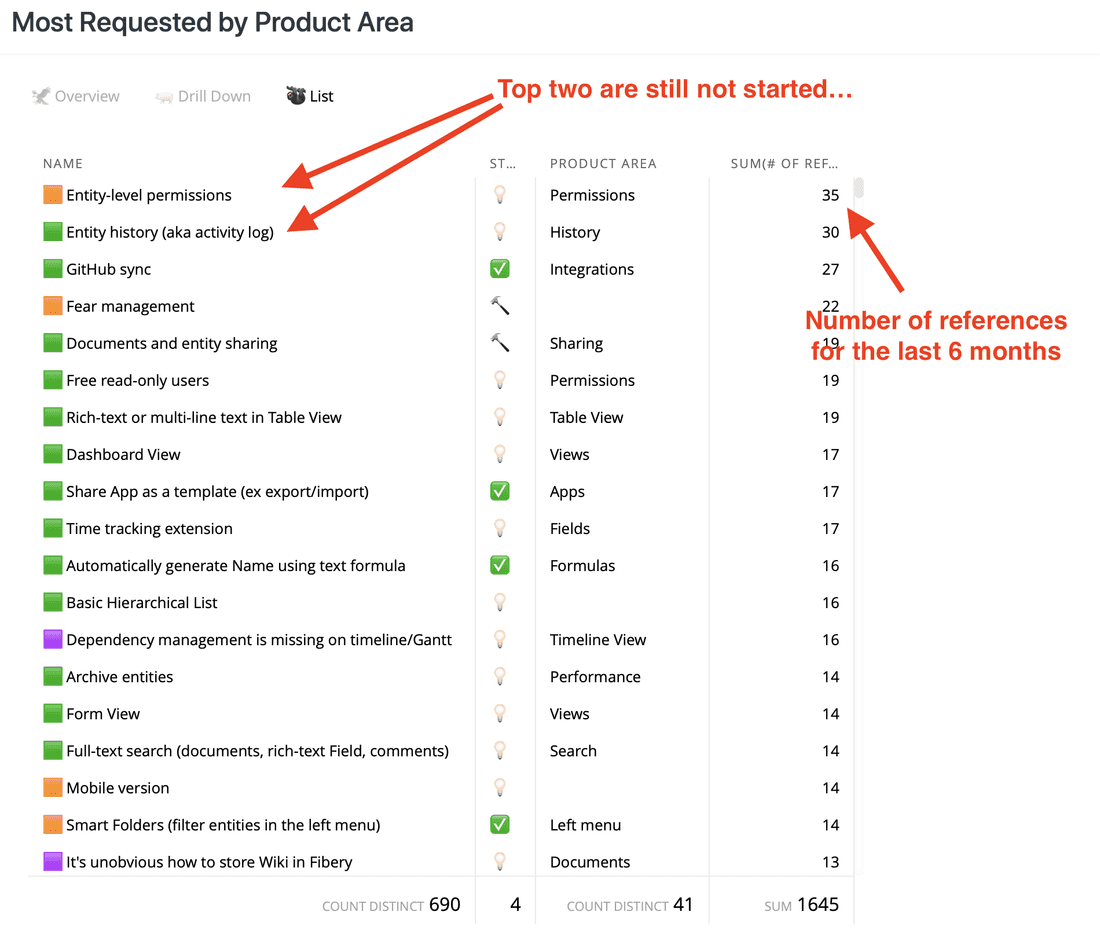
Indeed many people asking us about more granular permissions and entity changes history, so we have to take these into development ASAP.
We don’t use more advanced models, but definitely, you can create your own formula to calculate features’ importance and use a number of references as a parameter. We want to keep it simple and rely on references more since the voice of users mixed with our own vision is the most important thing.
🤔 Why Tags don’t work?
Many (all?) tools rely on tags to collect and categorize feedback. However, it doesn’t work. Imagine you have meeting notes from a call. There are dozens of feature requests, problems, and other things. If you just add 5–10 tags to the conversation, how to find the exact part of the text that is relevant for Integrations, let’s say? You have to scan the whole text in the meeting notes document.
The ideal solution is to highlight a part of the text and link it to a Tag/Feature/Idea. Product Areas in Fibery are similar to Tags, but what makes it really work is text link granularity.
Notifying customers about done Features
When some Feature is completed, we notify all requesters via Intercom or Email. This is a manual process so far, but the good thing is that we have all requesters linked to a Feature.
Quite often requests are added via Intercom, in this case, it is very easy to contact customers. You just navigate to Intercom conversation imported into Fibery, then click the direct link to Intercom chat and reply in Intercom directly.
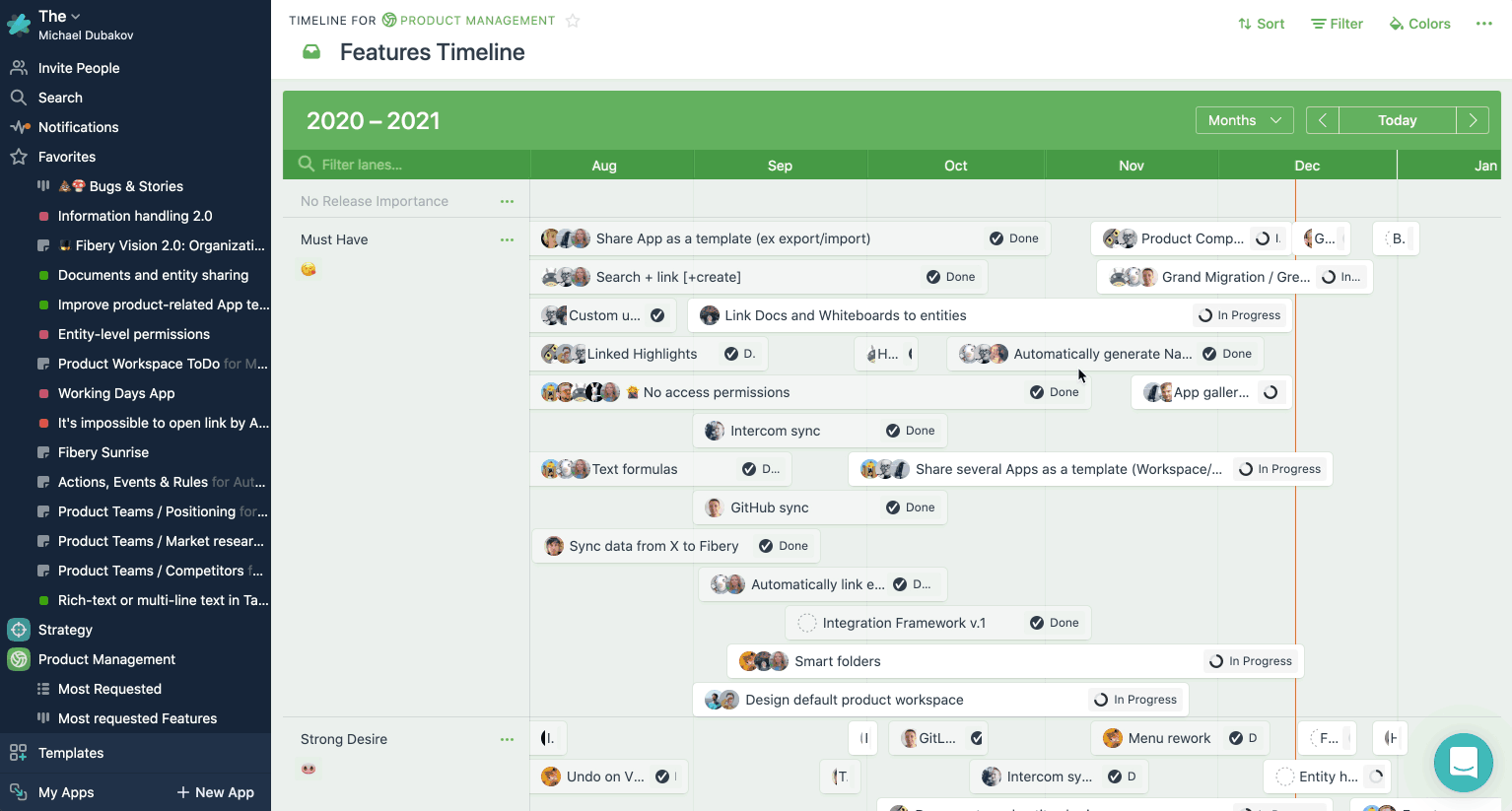
This video is a summary of feedback management and features prioritization in Fibery:
Ideation
We have a simple ideation space with a list of ideas. Each idea can be described by words and pictures, so we use these things. Here is an example of a well-developed idea about new ways of information handling in Fibery. It has a detailed description and two linked whiteboards.
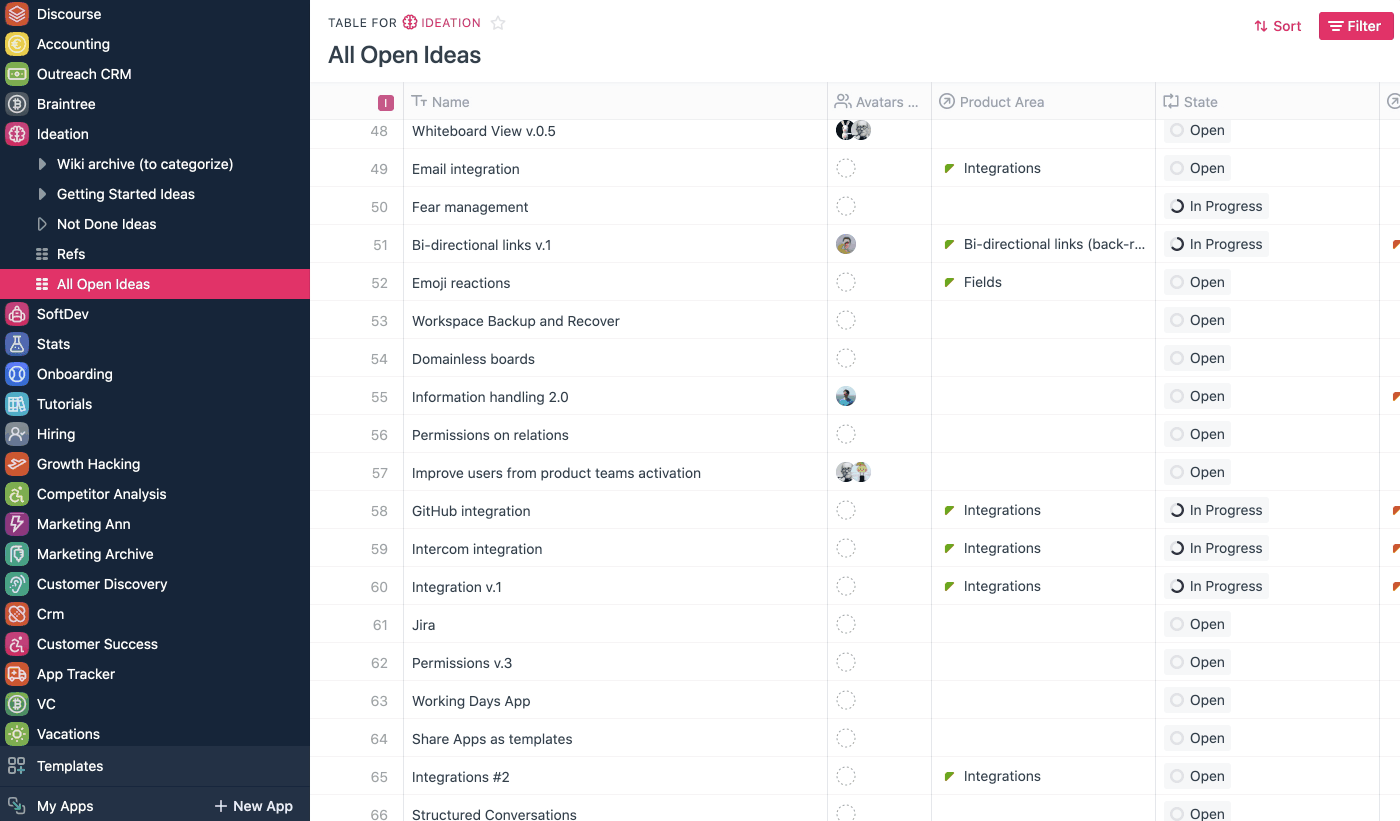
Whiteboards & Docs
We use Whiteboards pretty often to create diagrams and mind maps. For example, this one was created to explore Fibery setup for product companies. It helped a lot and we created a pretty similar Workspace for product companies.
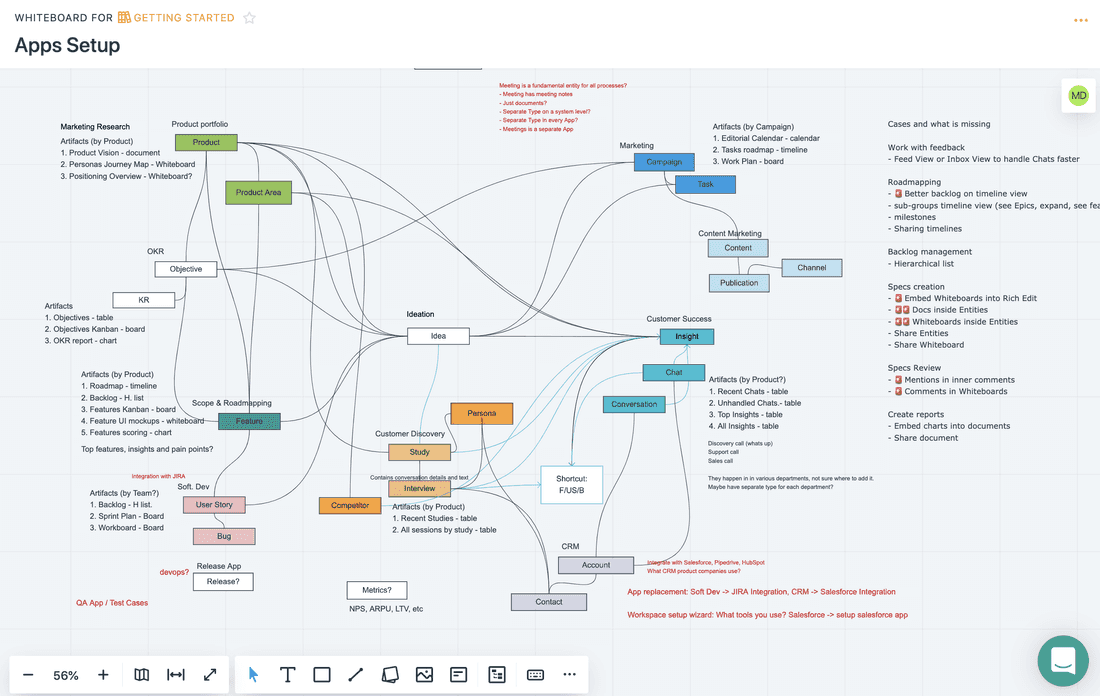
Every entity in Fibery can be a document and we use it all the time. We collaborate inside Fibery about proposals and ideas. The best thing is that you can easily mention other entities and link highlighted text to entities. Here are two examples:
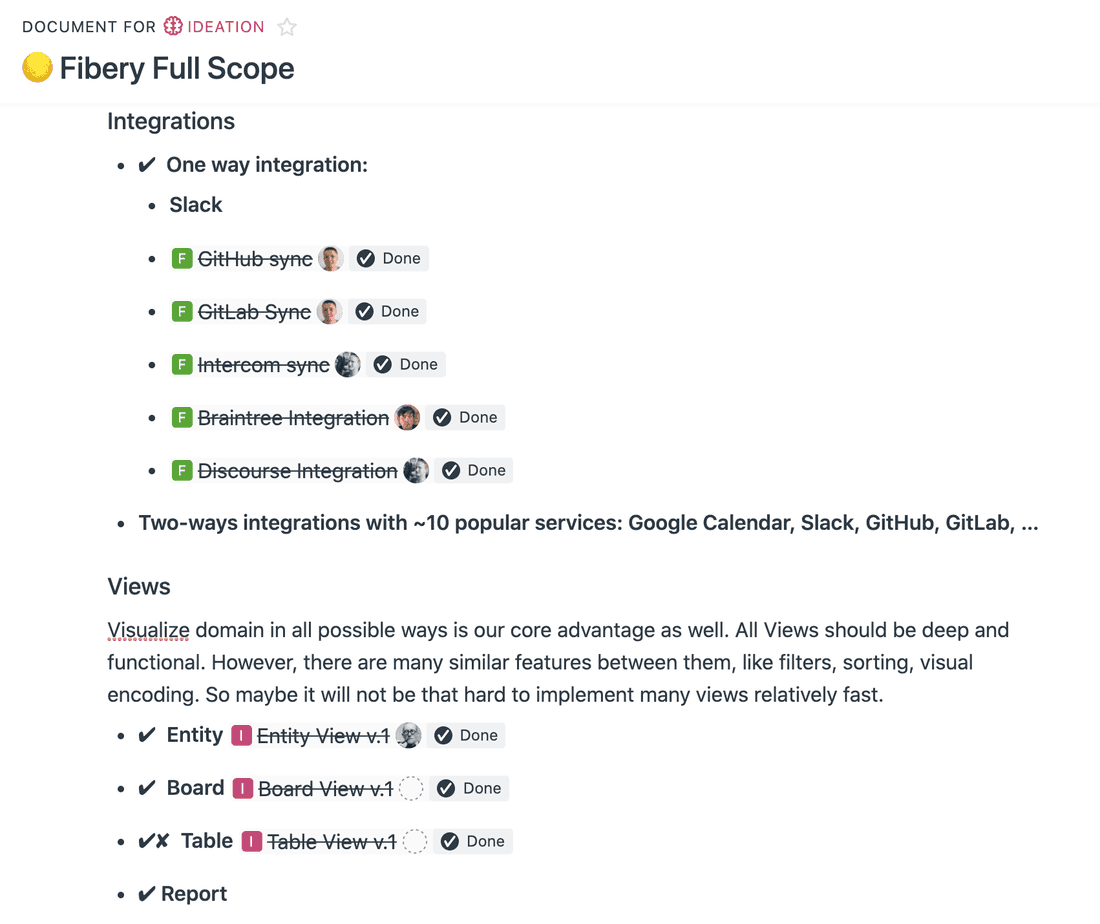
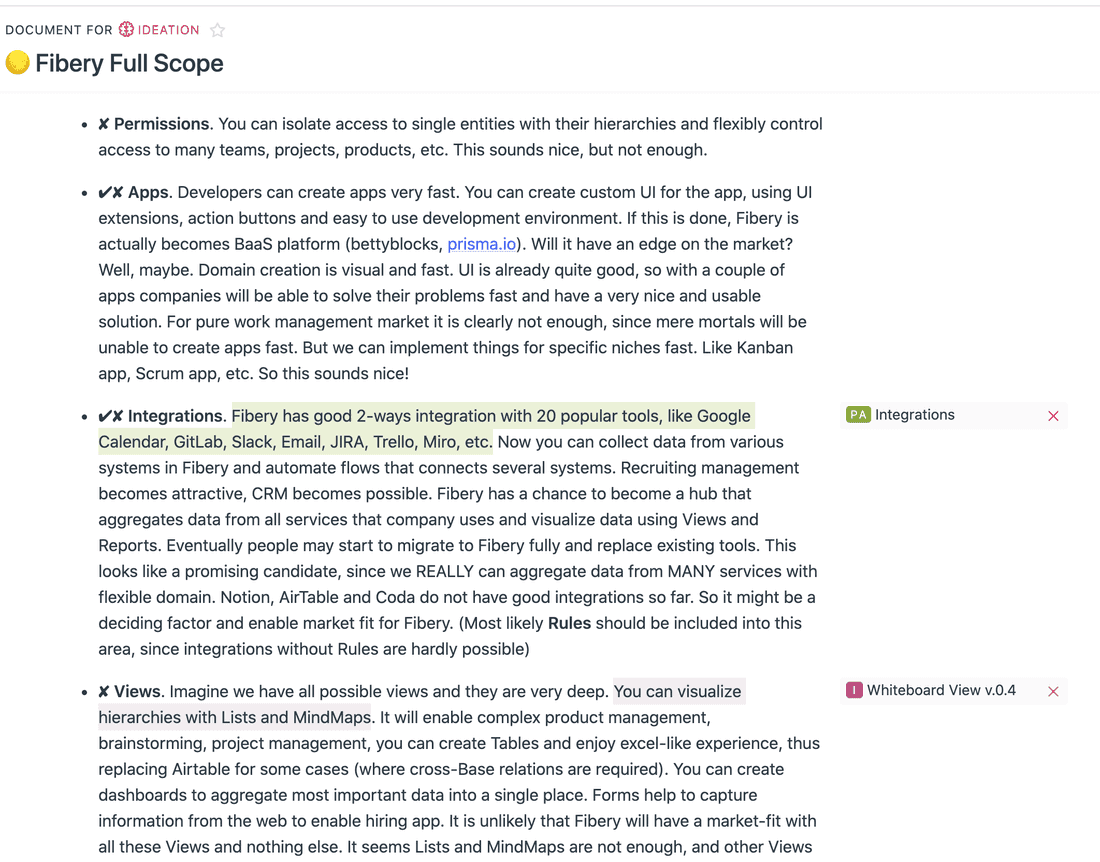
All such links are bi-directional, and this just glues information together so you can always find sources of Ideas and Features or dig into specific details. Here is how you navigate ideas from a vision document:
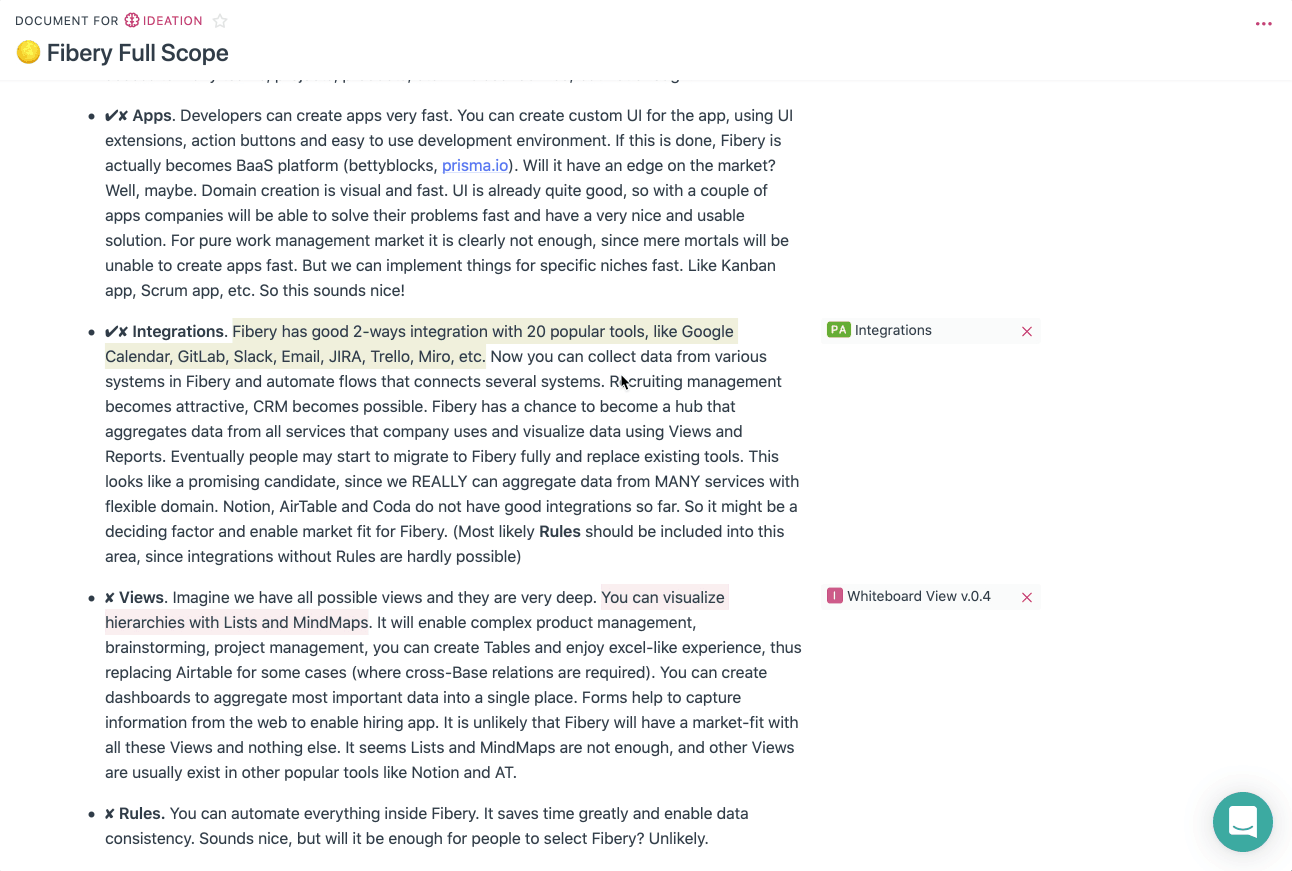
🤔 Why documents are important?
Ideas need a place to live and grow. Ideas can born anywhere, in a live conversation, in Slack messages, in Emails threads, but in the end they have to root somewhere and grow. Emails threads are not discoverable by other people and hard to follow. Slack messages are dispersed and hard to combine into a coherent structure. Collaborative documents is a great place to grow ideas.
Indeed, many people can work with a single source of truth, have internal comments threads about specific parts of the idea, enhance idea with diagrams and mindmaps. I believe a mix of collaborative documents and collaborative whiteboards provides a powerful toolset for ideation purposes.
Another problem is that you should have a single place for all ideation documents. What we see in many companies is that ideas live in Google Docs, Confluences, Zendesk, Jira and other services. People lose time to dig interesting pieces relevant for some idea, and often they just failed to do that. Central documents system that connects information together augments ideas and helps people invent.
CRM
We use Fibery as a CRM as well. When a new Account is registered from the fibery.io web site, it’s added to Fibery automatically (we use Workspace term for Account). We’ve accumulated about 15K accounts already. Here is a table with paid customers. We calculate Sales Cycle duration in days, MRR, and other metrics.
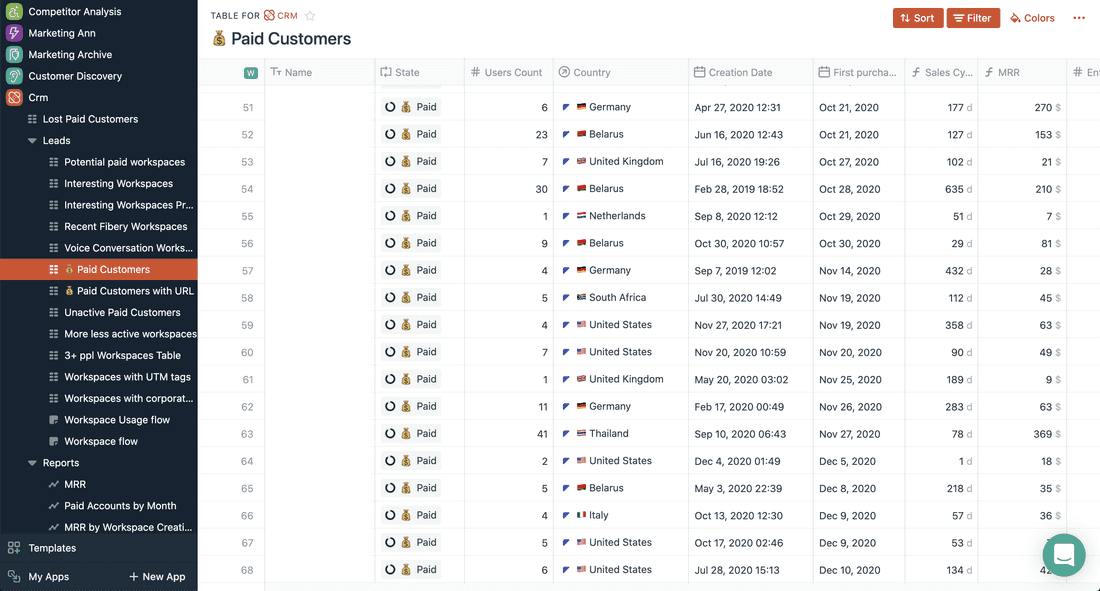
There are several cool things for us here. First, we link all Intercom conversations, all calls, and all other feedback to the Account, so when we open one, we can clearly see what was requested. Here is a pretty large customer with 40 licenses, and we see that this customer wants Dashboard View & embed Loom videos into Docs.
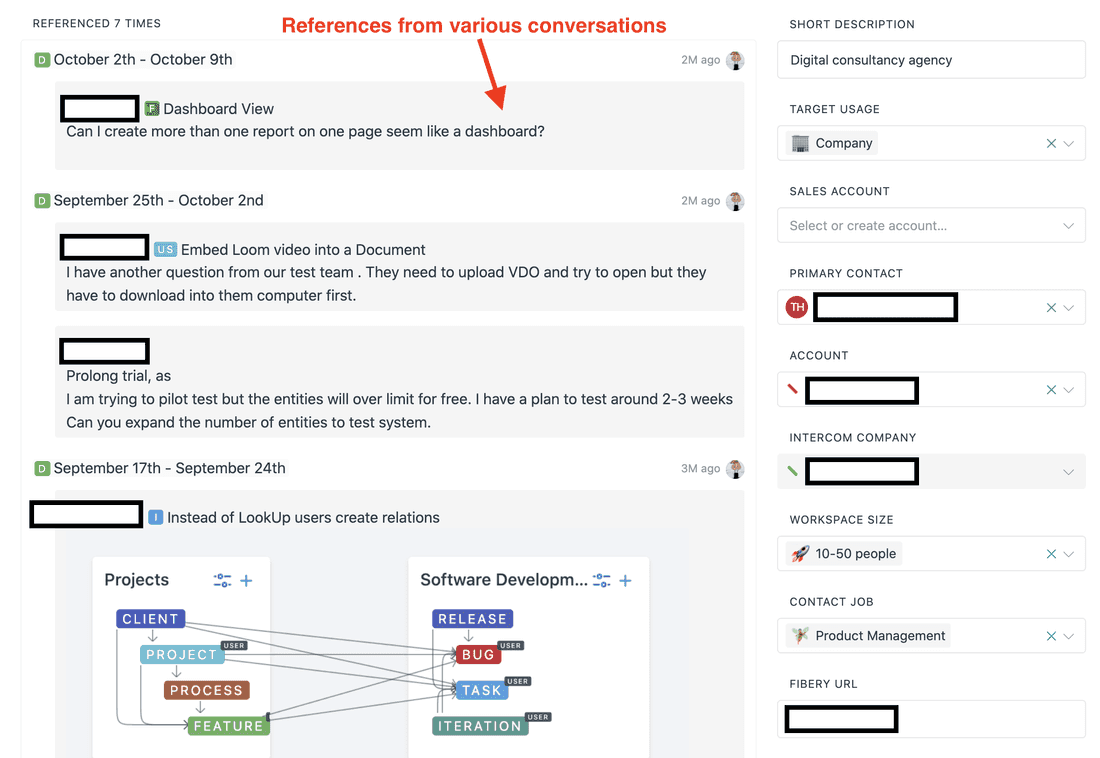
Braintree Integration
We use Braintree as a payment provider and all subscriptions and transactions are linked to Fibery Accounts as well. This helps us to calculate real MRR, quickly differentiate paid and non-paid accounts, see missing transactions, and canceled subscriptions.
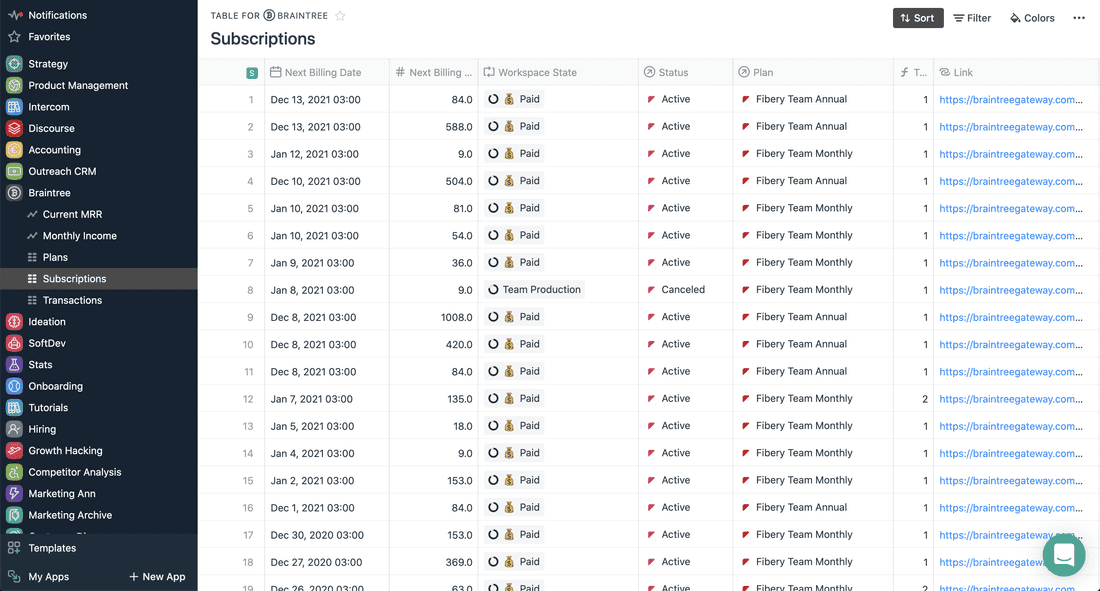
Subscriptions and Transactions are linked to Accounts. Here is an active account with a subscription and two transactions:
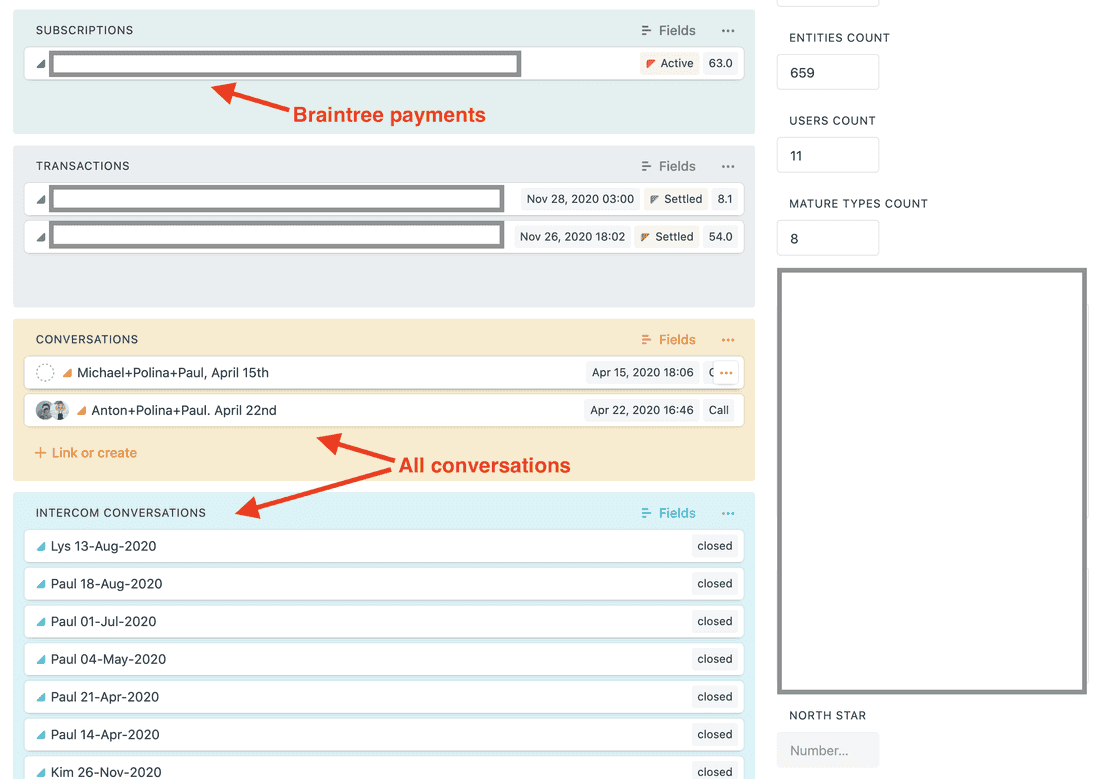
What is missing in our CRM is email integration. Currently, we can’t mass-mail customers or link replies to Accounts. Besides that, Fibery works as a decent CRM system. The main value is that we connect various information to the Account and it helps us to understand Fibery usage patterns better.
Software Development
Our Software Development process is quite simple, we use Kanban and track User Stories and Bugs on a single board:
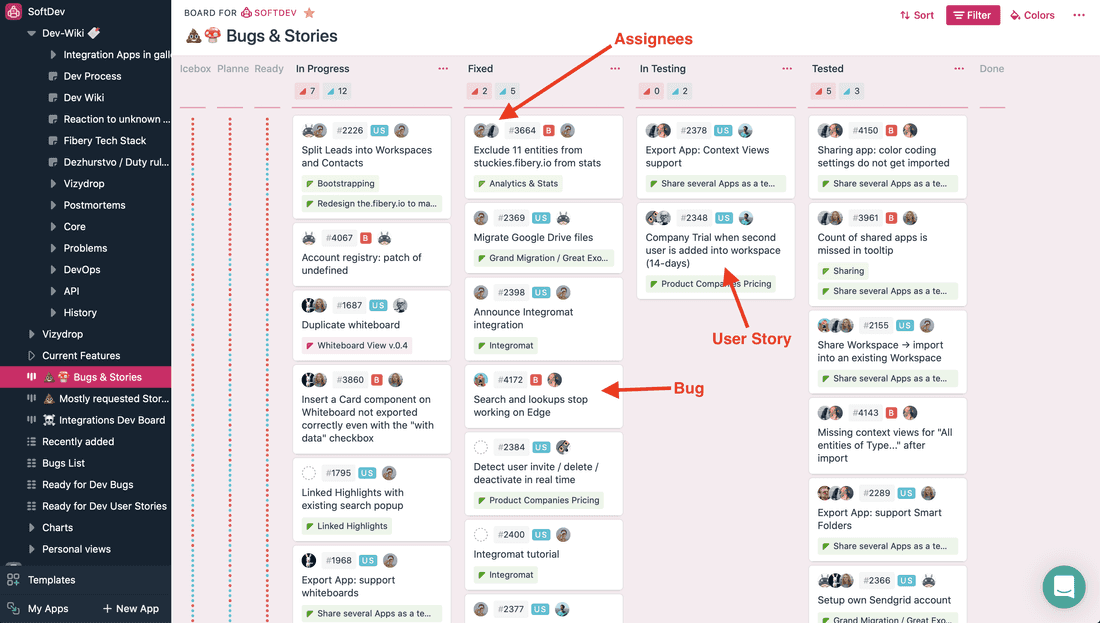
We have an edge environment where our own Fibery instance is running, and we have a production environment with all the customers. We update edge after each commit but update production on a weekly basis (almost). We tried continuous deployment, but some fixes were not fast enough and it caused disruptions for our customers, so we stick to weekly releases so far.
We don’t plan releases, just release what is ready every week. It usually includes everything in the Tested column and 1–2 Features.
Developers Wiki
Developers have their own wiki in this space and write docs about processes, technologies, incidents, etc.
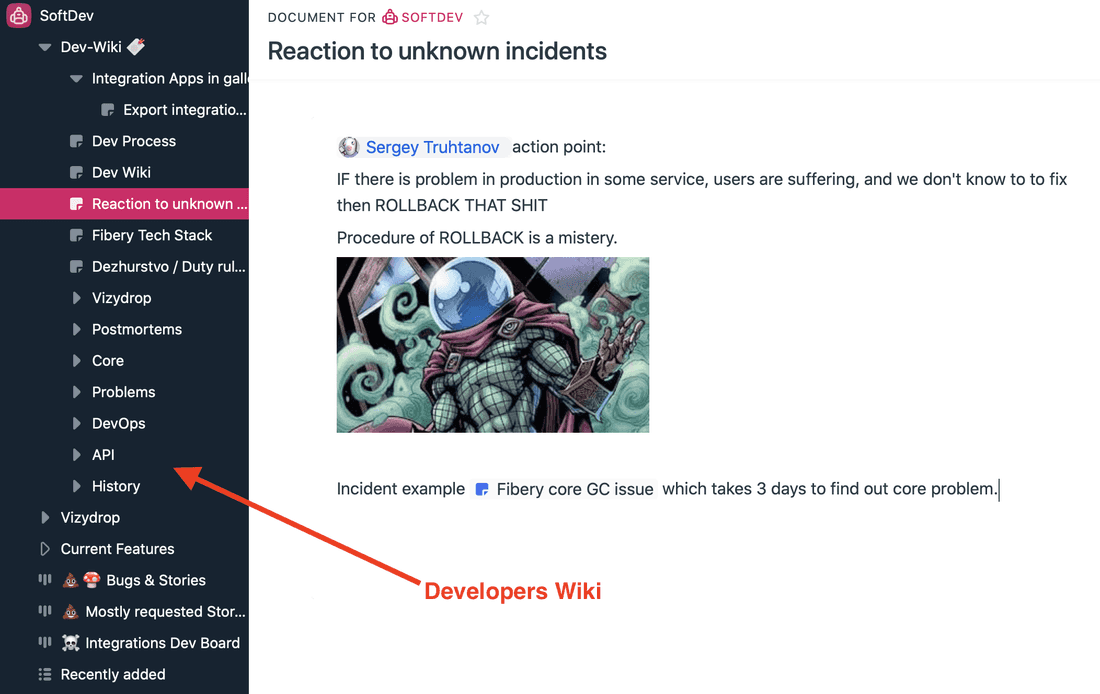
Competitors Tracking
Fibery does not live in a vacuum, so we have to sense the external environment. For example, we listen to what our leads and customers say about competitors and track this information to understand where Fibery works better, and where it works not so well.
This is a basic Space with a list of Competitors. During the call, we ask about the toolset and mention competitors in the call notes if any. Sometimes people mention competitors in Intercom chats, and we link this as well. As a result, we have a full list of references for all important competitors.
It seems Trello, Notion, Jira, and Airtable are the top 4 for us right now.
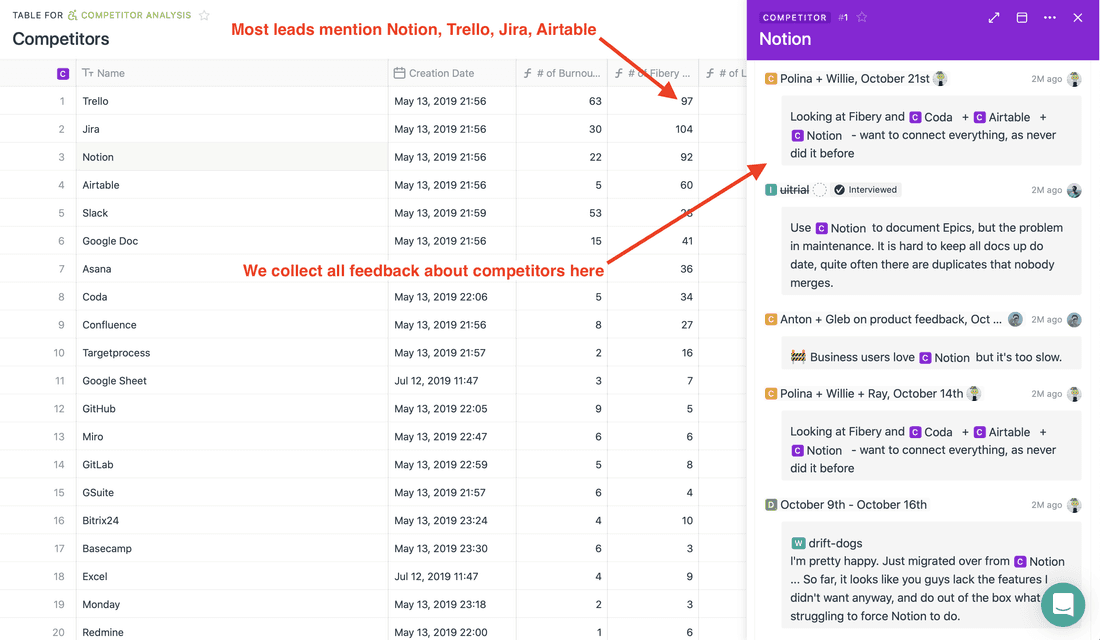
🦐 Failure: Outreach CRM
There was one process failure for us in all these years. We tried to setup Outreach Sales process in Fibery and failed. Here is the story.
We do almost everything in Fibery, so it was a natural step for us to map Outreach Sales process in Fibery as well. We’ve built the Space and all was fine, Fibery is flexible enough to support required structure with all the Niches, Sweeps, Touches, etc.
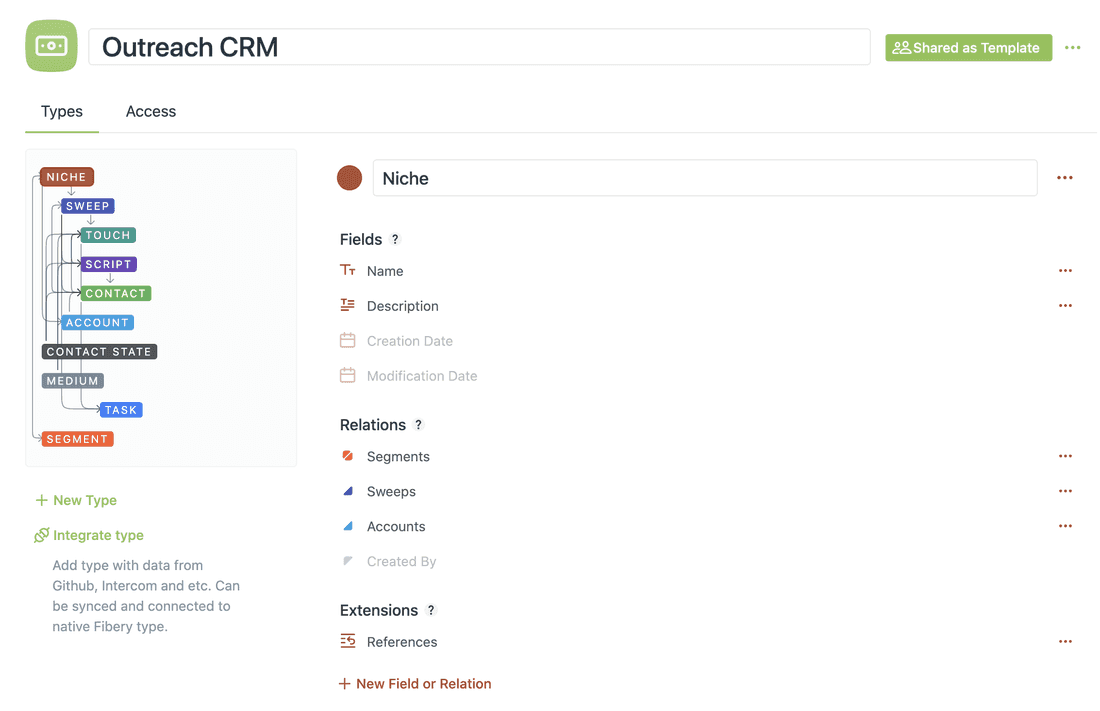
We started to collect Accounts and Contacts and Fibery and did two Sweeps with 100+ contacts and 1000+ touches.
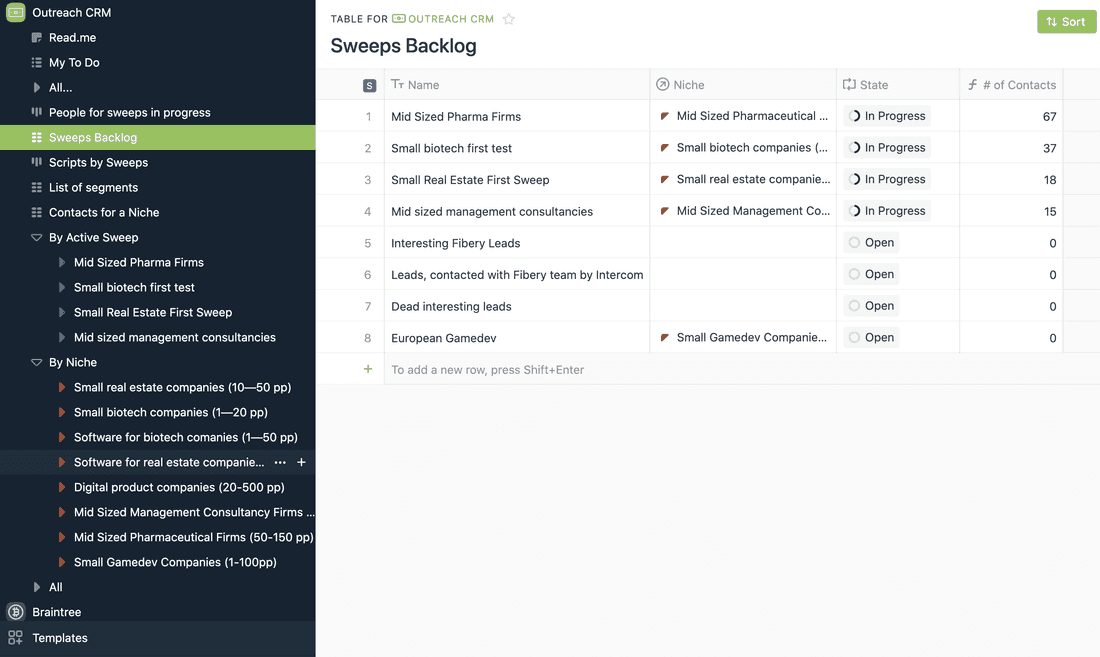
It was a disaster. There are two major problems with this space:
-
Adding Contacts is 10x slower than in specialized tools like snov.io. In snov.io you have a tool to automatically import contacts information from LinkedIn, but in Fibery you have to manually fill 10+ fields and it looks like a very dumb activity.
-
Emailing Contacts is a pain, since nothing is automated. You have to do it manually and track Touch status in Fibery. In specialized tools you can do it semi-automatically and it saves tons of time and cognitive effort.
We have to migrate to snov.io and abandon Outreach CRM process. To make it work we have to add Email Integration & LinkedIn Integration into Fibery, and some kind of email guesser to collect emails for the outreach campaigns. It’s not impossible, but it’s just out of scope of our current focus.
The conclusion is that Fibery is a decent swiss-army knife, but you have to have specialized tools as well 🔬.
Conclusion
We also use Fibery for vacation tracking, VC tracking, marketing management tracking, hiring activities, and some other processes. What are the main benefits?
-
🦄 As a company, we use fewer different tools and it’s quite easy to know where to find anything (in Fibery). All important information is stored in Fibery.
-
👍 From a product perspective, we understand customers’ demands much better and clearly see what to work on next.
-
👭 We can co-create things easier. There is a nice mix of collaborative documents and collaborative whiteboards so that we can put all relevant info inside an Idea and we can spot and set interesting connections, thus cross-pollinating ideas.
-
🐍 We can trace things from strategy to execution and see what Features we do for every Objective and what Stories we do for each Feature.
-
🔮 We can easily answer questions like: “What features this important customer asks?”, “What customers ask this interesting idea? We should contact them and ask some questions”, “What type of customers stick better? (product companies)”, “What type of customers stick worse? (digital agencies)”, “Who will be on vacation next week?”.
—
If you want to use Fibery inside your product company, 🌶 give it a try.
Psst... Wanna try Fibery? 👀
Infinitely flexible product discovery & development platform.